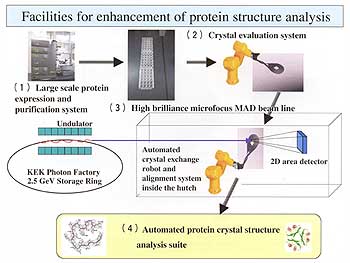Target oriented structural genomics: research consortia concept
-- National project of determining 3000 unique folds in 5 years from FY2002
There are many national and international genomics projects started in the last few years. For instance, the National Institute of Health in the USA is funding 9 consortia, which pursue pilot SG projects with different targets. In Europe, there is a new initiative of coordinating European laboratories to focus on SG relevant to human health. In Japan, RIKEN has a major SG program based on the NMR and synchrotron X-ray techniques while the Biological Information Research Center of the METI concentrates on membrane proteins and National Institute of Agrobiological Sciences of the Ministry of Agriculture, Forestry and Fisheries is developing a SG project on rice.

The Life Sciences Division of the Ministry of Education, Culture, Sports, Science and Technology is starting a five-year project of determining 3000 structures or unique folds from April 2002. The SG project at RIKEN will carry out the major part of the Protein 3000 project. Their primary goal is to contribute to the worldwide effort of determining all the representative structures in the structure space by determining 2500 structures in the next five years.
On the other hand, structural biologists of the Japanese universities and the Photon Factory (PF) have been proposing a network of SG consortia to pursue target-oriented SG projects aimed at specific biological or medical targets
Each consortium will consist of X-ray protein crystallography and NMR groups tightly coupled with researchers specialized in medical, pharmaceutical and biological sciences who share the same biological interests in their pursuit of structure-function relationships.
We emphasize following important factors in the preparation stage of our proposal:
- Initiative of the researchers of universities and research institutes
- Close collaboration with biochemistry, molecular and cell biology, medicine, pharmacology departments of the universities and research institutes
- Research and development of key technologies
- Improvement of the overall efficiency of structure determination by a factor of 10
- Determination of 500 biologically-important protein structures
- Education of the next generation of structural biologists
It is important to note that R&D of high throughput technologies is essential to achieve the goal. Moreover, the essential technologies are still not matured for truly high throughput operations, and therefore it is necessary for different SG consortia in the world to pursue R&D projects in parallel at this stage. Here, it is more efficient to concentrate on the R&D projects to solve the bottlenecks of the structure determination as shown in the diagram of our proposal of a target-oriented SG consortium.
